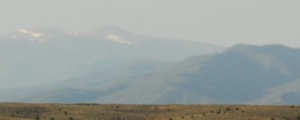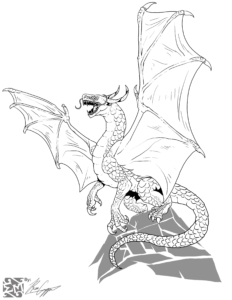
Southwestern Mountain Ranges
Photograph by Nancy E. Rogers
A Rare Glimpse
H’Ilgraith led Jak to the prairies and mountains in the southwestern region of H’Aleth. When they entered the foothills of the mountains, H’Ilgraith suddenly asked Jak, “What do you know about dragons?”
“Very little,” he replied. Then it hit him. “There are dragons in these mountains,” he stated grimly, looking at H’Ilgraith. “What are we doing here?”
“Looking at the scenery,” H’Ilgraith answered facetiously.
Not long afterwards, a shadow passed overhead. A male red dragon had flown over them. Jak glimpsed the glitter of the dragon’s iridescent scales in the sunlight. As H’Ilgraith and Jak looked up, the dragon banked and turned back. (Excerpt from H’Ilgraith, Sister of the House of H’Aleth)

A Male Red Dragon
Illustration by Epic Made
Southwestern Mountain Ranges
Southwestern mountain ranges include the Sierra Nevada (California), Great Basin Desert (Nevada), Unita Range (Utah), Rocky Mountains, (Colorado, New Mexico), and Guadalupe Mountain range (southwestern New Mexico and west Texas) among many others. There are several diverse environments in these settings: desert (e.g., the Chuhuahuan), canyons, caves, limestone caverns (e.g., Carlsbad Caverns), river woodlands of oak and maple, and high mountain forests of pine and fir.
Each of the above ecological regions have wildlife adapted to living in them. The deserts host coyotes, kit foxes, bobcats, and badgers. River woodlands host skunk, raccoons, and mule deer. Alpine forests support elk, black bear, gray fox, gray wolves, mule deer, and cougars. Caves and caverns host bats and (imaginary) red dragons. Although only mammals are cited above, there are many other classes of animals that inhabit these regions.
Shelter and Disguise
In the novel Homo transformans: The Origin and Nature of the Species, humans initially could not undergo metamorphosis. In some members of Homo sapiens, however, this process was amended after a massive stellar eruption in the galaxy released a powerful gamma ray burst that struck Earth. Loss of the ozone layer led to a mass extinction similar to the Ordovician. Life forms sensitive to radiation damage were lost unless they were protected deep underground. Since humans were not resistant to radiation, people sheltered in caves and caverns. Generations later, a new characteristic began to arise in some humans. They could transform into other species of animals.
The Guadalupe Mountains harbor archeological evidence of human habitation dating back 10,000 years. So, it would not be surprising that the people from the Houses of H’Aleth and Erwina would consider sheltering from radiation or hiding from an enemy by fleeing into the southwestern mountains. There, they could shelter in caves and caverns. Those who could transform in species native to various regions could fade into the desert or dense forests and remain hidden.